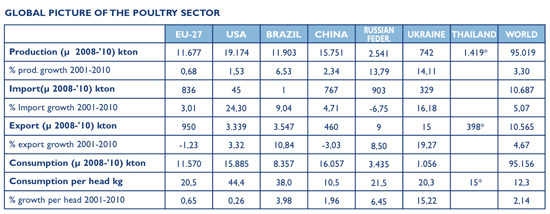



Poultry Meat – a Sustainable EU Market
Poultry meat looks likely to remain a popular meat with consumers and it has a low environmental impact compared with other meats but the supply to the EU will be met increasingly by imports from outside the region, according to the Association of Poultry Processors and Poultry Trade in the EU Countries, a.v.e.c., in its 2011 Annual Report.EU Food Security and Poultry Meat Supply
EU food security is under pressure. The net trade position of the EU poultry meat sector is projected to deteriorate over the next 10 years driven by a steady increase in meat imports (mainly of poultry meats and beef) and a parallel decline in meat exports (of poultry, beef and pig meats).
The food choices we make do not only influence our own health, they also have a large impact on the environment. Over the last 50 years, diets in the EU, generally, have shifted towards higher consumption levels of meat, fish and dairy. A similar shift is currently taking place in parts of Asia and South America, leading to a strong rise in global demands for meat, dairy and fish with consequential increases in environmental impacts.
Greenhouse Gas Emissions Lowest for Poultry
EU citizens consume 12 per cent of global meat consumption and the consumption per capita is about 23kg, twice the global average. The additional amount of land needed for the production of animal protein to meet increasing demands for meat as income levels increase depends on the efficiency of the production type selected. Depending on the production type the emissions will increase more or less. Resource efficiency of the animals matters.
The efficient digestion process and the absence of enteric fermentation place poultry meat as the most sustainable meat in terms of low values of greenhouse gas emissions. In terms of carbon footprint and land use per kilo of product, life cycle assessment studies show that the production of poultry compared to other meat producing species emits less carbon dioxide and uses only half the land (expressed as square metres per kg) than pigs. Only fish and milk as supplies of animal protein have lower impacts. Nevertheless,further improvement should be possible and the poultry businesses are committed to work on that.
It makes sense to promote efficient and sustainable EU poultry meat production.

Factors Affecting Consumption of Poultry Meat
The relatively low and competitive pricing of poultry compared to that of other meats, the relative absence of cultural or religious obstacles, and dietary and nutritional (protein) qualities are the main factors explaining its attractiveness.
Meat, dairy, eggs and fish are important components of the European diet. These animal products are not only important in terms of taste and tradition; they also provide essential nutrients such as proteins, iron, calcium and vitamins. Livestock production and fisheries are important economic sectors for Europe's rural areas.
In recent years climate changes, volatile input prices, unfavourable trade agreements and political instability have affected poultry production. The effect has been forcing costs upwards and if the current pessimism is followed by poor harvests grain prices could stay high. European poultry production costs are increasing and margins are squeezed.
Facts about European Poultry Meat Production
- Main user of cereals, about 16 per cent of wheat and maize production in the EU.
- The 2nd meat producer after pork in Europe.
- The poultry sector is one of the least supported sectors in the EU by the CAP.
- Meat production (2010): 11,642,000 tonnes carcass weight.
- Slaughtered animals for meat production (2010): 6.036 billion animals.

References
- La situation mondiale de l'alimentation et de l'agriculture, FAO, 2009
- Prospects for agricultural markets and income 2010-2020, DG AGRI, 2011
- Global Agriculture towards 2050, FAO, Rome, October 2009
- Brazil is the world's leading chicken exporter in 2011 (Black Sea Grain)
- Westhoek, H. et al. (2011) The Protein Puzzle, The Hague: PBL Netherlands Environmental Assessment Agency
- Van Horne P.L.M. and Achterbosch T.J. 2008. Animal welfare in poultry production systems, impact of European Union standards on world trade. LEI/WUR, 2008
- Press release, EPP Group Press and Communications Service, 22.06.2011
- Eurostat
- OECD
- Agri-Outlook
- International Poultry Production 19 (4), 2011.








